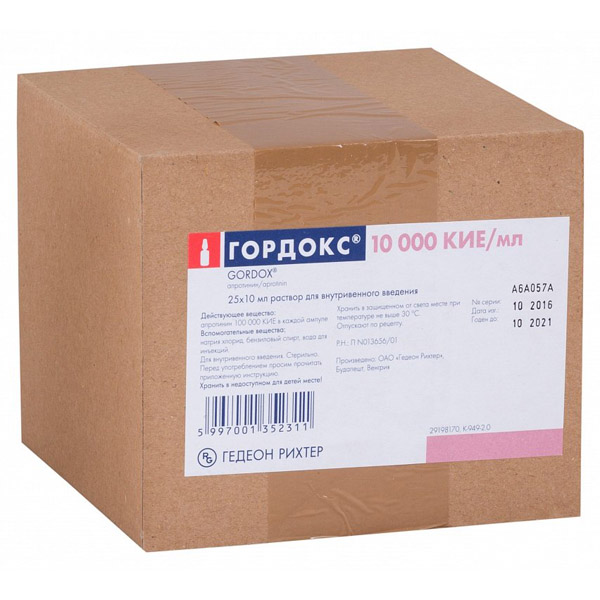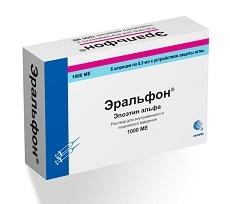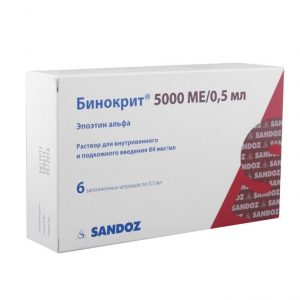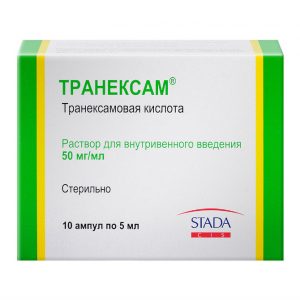Description
Latin name
Gordox
Dosage form
Solution for intravenous administration
Packing
25 ampoules of 10 ml.
Pharmacological action
Antiprotease, antifibrinolytic.
Gordoks inactivates proteinases (plasmin, kininogenases, trypsin, chymotrypsin, etc.) in plasma and tissues reduces blood fibrinolytic activity.
Indications
Therapy for primary hyperfibrinolytic bleeding (post-traumatic, postoperative, especially during surgical interventions on the prostate gland, lungs).
Open-heart surgery to reduce bleeding and to reduce the need for blood products.
Acute pancreatitis, exacerbation of chronic pancreatitis, pancreatic necrosis.
Surgical interventions (including diagnostic ones) performed on the pancreas and on the abdominal organs adjacent to it (for the prevention of enzymatic autolysis of the pancreas).
Shock (toxic, traumatic, burn, hemorrhagic).
Extensive and multi-layer traumatic tissue injuries.
Massive bleeding (during thrombolytic therapy).
Extracorporeal circulation.
Prevention of postoperative pulmonary embolism and bleeding, fat embolism in multiple injuries, especially fractures of the lower extremities and skull bones.
Contraindications
age up to 18 years (efficacy and safety not established)
hypersensitivity to the components of the drug.
Use during pregnancy and lactation
Studies on the use of the drug Gordoks in pregnant women have not been conducted. In pregnancy, use is possible only in cases where the intended benefit to the mother outweighs the potential risk to the fetus.
When assessing the benefit / risk ratio, one should take into account the negative effect on the fetus of severe adverse reactions possible with the use of the drug, such as anaphylactic reactions, cardiac arrest, etc., as well as therapeutic measures taken to eliminate these reactions.
The use of the drug Gordox during lactation has not been studied. The drug is potentially safe if it passes into the body of a child with breast milk, since it does not have bioavailability when taken orally.
Dosage and administration of
I / O, slowly.
The maximum rate of administration is 5 10 ml / min. With the introduction of the drug, the patient should be in a supine position. Gordox ® should be administered through the main veins and not be used to administer other drugs.
Due to the high risk of allergic / anaphylactic reactions, all patients should be given a test dose of 1 ml (10 thousand KIE) 10 minutes before the main dose of Gordox ®. In the absence of negative reactions, a therapeutic dose of the drug is administered. It is possible to use histamine H1 and H2 receptor blockers 15 minutes before the administration of Gordox ®. In any case, standard emergency measures aimed at treating an allergic / anaphylactic reaction should be provided.
Adults: initial dose of 1 2 million KIU, administered iv slowly for 15 20 minutes after the start of anesthesia and before sternotomy. The next 1 2 million KIEs add heart-lungs to the primary volume of the apparatus. Aprotinin should be added to the primary volume during the recirculation period to ensure sufficient dilution of the drug and to prevent interaction with heparin.
After the end of the bolus administration, a constant infusion is established at a rate of administration of 250 500 thousand KIU / h until the end of the operation. The total amount of aprotinin administered throughout the course should not exceed 7 million KIU.
Patients with impaired renal function: no dosage adjustment needed.
Children: the drug is contraindicated under the age of 18 years (efficacy and safety have not been established).
Elderly patients: Changing the dosage regimen in elderly patients is not required.
Side effects
Allergic reactions: rarely – allergic, anaphylactic, anaphylactoid reactions very rarely – anaphylactic shock (potentially life-threatening).
In patients receiving aprotinin for the first time, the development of allergic or anaphylactic reactions is unlikely. With repeated administration, the frequency of development of allergic (anaphylactic) reactions can increase up to 5%, especially with repeated use of aprotinin for 6 months.
With repeated use of aprotinin after more than 6 months, the risk of allergic / anaphylactic reactions is 0.9%. The risk of developing severe allergic / anaphylactic reactions increases if aprotinin has been used more than 2 times within 6 months. Even in the event that with the repeated use of aprotinin no symptoms of allergic reactions were observed, subsequent use of the drug can lead to the development of severe allergic reactions or anaphylactic shock, in rare cases with a fatal outcome.
Symptoms of allergic / anaphylactic reactions are manifested by disorders of the cardiovascular system (arterial hypotension), the digestive system (nausea), the respiratory system (asthma / bronchospasm), and the skin (itching, urticaria, rash).
If hypersensitivity reactions develop with aprotinin, you should immediately stop the administration of the drug and ensure that standard emergency measures are carried out – infusion therapy, the introduction of adrenaline / epinephrine, corticosteroids.
From the cardiovascular system: infrequently – myocardial ischemia, thrombosis / occlusion of the coronary arteries, myocardial infarction, pericardial effusion, thrombosis rarely – arterial thrombosis (with possible manifestation of dysfunction of vital organs such as kidneys, lungs, brain) very rarely – pulmonary embolism.
From the hematopoietic system: very rarely – coagulopathy, incl. DIC syndrome.
From the urinary system: infrequently – impaired renal function, renal failure.
Local reactions: very rarely – reactions in the area of injection / infusion, thrombophlebitis.
Drug Interaction
Co-administration of Gordox with streptokinase, urokinase, alteplase decreases the activity of these drugs.
Pharmaceutical Incompatibility
Gordox is compatible with 20% glucose solution, hydroxyethylated starch solution, lactated Ringer’s solution.
Gordox should not be mixed with other drugs.
Overdose
There have been no reports of overdose with the drug at this time.
There is no antidote to the drug.
Storage conditions
The drug should be stored out of the reach of children, protected from light at a temperature not exceeding 30 ° C.
Expiration
5 years.
Deystvuyuschee substances
aprotinin
dosage form
dosage form
injection
Gedeon Richter Vengriya




